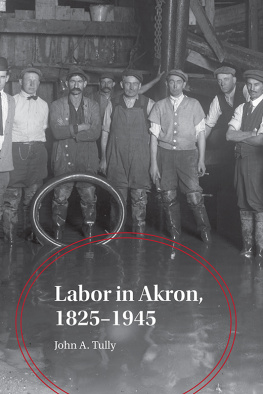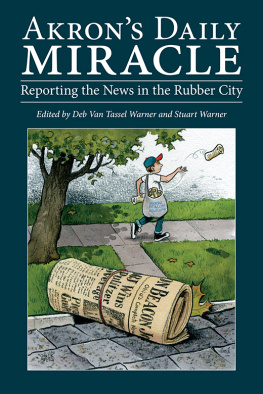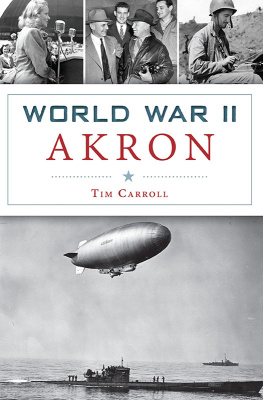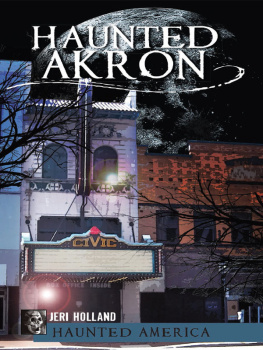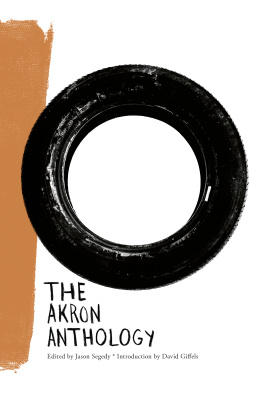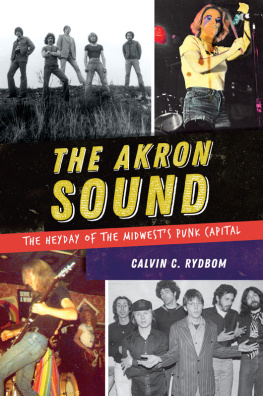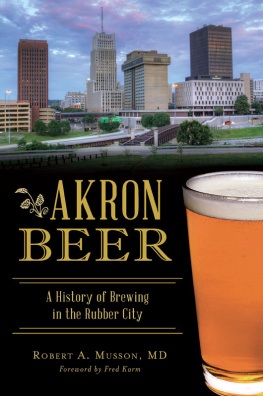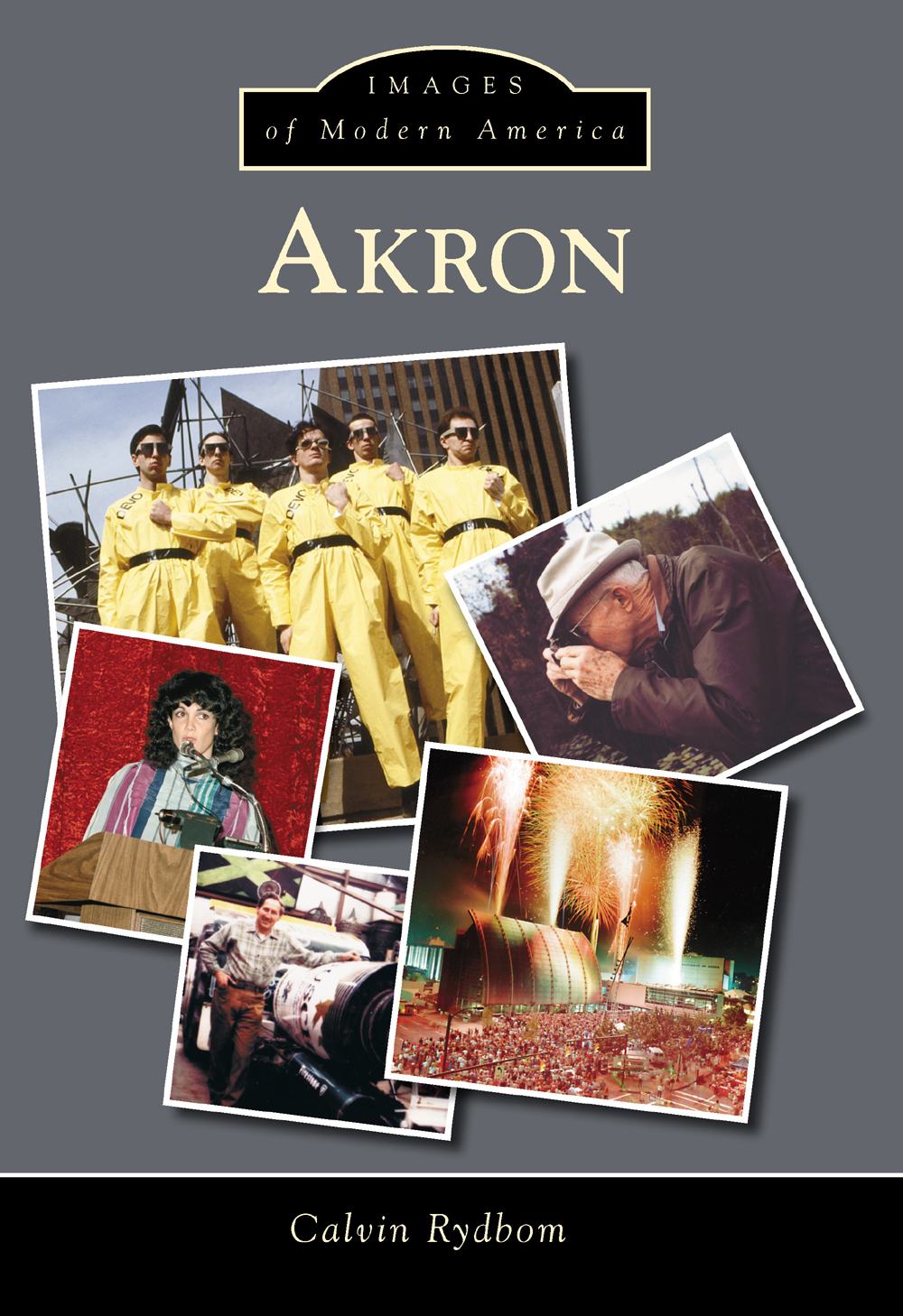
IMAGES
of Modern America
AKRON

Since the R&B group Ruby & the Romantics had a number of hits in the early 1960s to acts today like The Black Keys, If These Trees Could Talk, Ripper Owens, and Joseph Arthur, Akron and music have been intertwined. Many Akron fans enjoy their nights at Musica, where Arthur performs here in 2008, and its neighbor and premiere Jazz club in Akron, Blue Jazz. (Photograph by Shan Spyker/Sisters Dissonance.)
ON THE FRONT COVER: Clockwise from the top left, Akron rock icons Devo in downtown in the 1970s (photograph by Janet Mocaska); Congressman, environmentalist, and Firestone scion John Seiberling taking a photograph in one of Akrons parks (courtesy of the John F. Seiberling collection); fireworks at the Inventure Place and Inventors Hall of Fame grand opening in 1995 (photograph by Bruce Ford); three-time world speed record holder Art Arfons at his Akron shop in the 1970s (photograph by Ott Gangl); NASA astronaut Judith Resnik, who lost her life in the 1986 Challenger disaster (photograph by Bruce Ford).
ON THE BACK COVER: From left to right, the Everett Covered Bridge, the only remaining covered bridge in Summit County and one of the top 10 places for photography on public lands according to the National Part Foundation (photograph by Lew Stamp); Akron Aeros mascot Orbit and fan in during the Aeros inaugural season (photograph by Ed Suba); the Akron sitting in its hangar in the late 1980s (photograph by Robin Witek).
IMAGES
of Modern America
AKRON
Calvin Rydbom

Copyright 2015 by Calvin Rydbom
ISBN 978-1-4671-1528-5
Ebook ISBN 9781439654101
Published by Arcadia Publishing
Charleston, South Carolina
Library of Congress Control Number: 2015945201
For all general information, please contact Arcadia Publishing:
Telephone 843-853-2070
Fax 843-853-0044
E-mail
For customer service and orders:
Toll-Free 1-888-313-2665
Visit us on the Internet at www.arcadiapublishing.com
CONTENTS
ACKNOWLEDGMENTS
I went into this project fairly sure of myself; it was not my first book or even my second. And if you look around, you will find few websites commemorating some aspect of what we usually think of as history.
But they were easy compared to this book. It seems people do not find their day-to-day lives particularly historical. So, when you go around looking for images of the longtime deli or store that was on the corner until 1992, people seem perplexed. Why would they have taken photograph of the place they went to for cheesecake? That is not history.
The thing is, those photographs are just as historical as one from 1860. They still tell the story of the people who were there. It made it difficult, and frankly there are a few images I simply never found for places that meant something to me in 1986, which of course meant I assumed it was important to everyone living in Akron and Summit County in 1986.
I would not have been able to write this book without the help of more people than I could possibly list. But those I should list are Bruce Ford, who as the official photographer for the City of Akron was a huge help and asset; Jimi Imij, whose archives and knowledge of Akron and the Akron music scene seemed always at my disposal; and John Phillips, who one day about 55 years ago walked around downtown Akron snapping photographs and was more than happy to let me use them. My editor at Arcadia Publishing, Liz Gurley, gave constant encouragement and thanked me for being one of those authors who constantly kept her up to date on my progressalthough I am a tad suspicious about how glad she was to get five or six emails from me some days.
Lastly, I would like to thank my two office mates at Pursue Posterity: Keith Peppers and Thomas Kubat. I missed working with Thomas on this book, as he had cowritten the last two with me, but he was very busy with some other projects at the office to do more than encourage this time around. This left no one to give me a somewhat annoyed grimace when I played fast and loose with the rules of grammar.
INTRODUCTION
If any city deserves to have its modern history discussed it is Akron, Ohio. The story of Akron can easily be broken into different eras, and the odd thing is we still tend to think of ourselves in terms of the old story, of old Akron. Ask someone what the nickname of Akron is and they will tell you it is the Rubber Capital of the World, or the Rubber City. While Goodyear still maintains its corporate headquarters in Akron and Firestone still has a large presence in the community, rubber, at least in its traditional form, is hardly the focus of Akron anymore. Between 2000 and 2007, the numbers of rubber workers in Akron was cut in half. No longer was a boys goal to get a good job at Goodyear, Goodrich, Firestone, or General Tire and spend the rest of his life making tires.
No, the place that won the All-American City award in 1981, 1995, and 2008 bills itself as the City of Invention now. We are cutting-edge science; we are the center of Polymer Valley.
This book is a pictorial history of the journey Akron made from around 1960 to the present. There are so many topics I could have covered when thinking about Akron over the last 55 years. After giving it some thought, I knew I had to discuss the changing downtown and its ups and downs. Someone walking down South Main Street in 1960 would not recognize it today. I had to consider what we did outside of downtown, the places where we spent time, and a little bit about the neighborhoods. Any good Akronite knows there is a difference between being from Kenmore, North Hill, or Highland Square. In addition to the distinct neighborhoods, Akron is home to some beautiful parklands, both in the county park system and the national park that runs along the Cuyahoga River,
Akron has had some colorful people lead the city, and as such it was a must that some of the larger-than-life figures of city hall be included. We also have a pretty impressive art and culture scene going on here as well. So I had to work that in as well.
The University of Akron had to have a spot; it is too important to our town to be ignored. The Zips, along with other sports teams that played in town, kept competitive juices flowing. And, of course, the music scene reached international renown in the late 1970s and early 1980s. The Akron sound became so distinctive that clubs in London were having Akron nights. Today, it is still producing artists such as The Black Keys, If These Trees Could Talk, and Joseph Arthur.
Modern Akron started in the early 1960s with the destruction of downtown that Akronites of the 1940s and 1950s had become accustomed to. According to the 1960 census, 290,351 lived in Akron, the pinnacle of the citys population. Between 1959 and 1961, the Quaker Oats Building disappeared from the landscape, and numerous mainstay businesses made way for the Cascade Superblock. People stopped shopping downtown as much when Summit and Chapel Hill Mall opened in the 1960s. A third mall, Rolling Acres, opened in 1975, and downtown as a shopping district was more or less over. The story of stores moving into the suburbs was not unique to Akron in the late 1960s. Unfortunately, neither was civil unrest. The Wooster Avenue Riots erupted in 1968, and Akron did not seem such a quiet Midwestern town anymore.
By 1970, the citys population had reduced to 275,425, and Akron was starting to shrink. In fact, it was only the second US census that had recorded a reduction in population, and it was the largest. The reduction between 1970 and 1980 would almost triple in magnitude. Downtown mainstays such as Polskys and ONeils disappeared along with that reduction in population.
Next page

